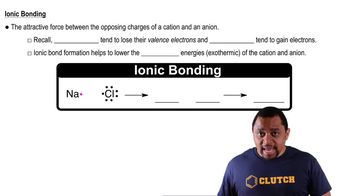Write balanced chemical equations to correspond to each of the following descriptions: (a) When sulfur trioxide gas reacts with water, a solution of sulfuric acid forms. (b) Boron sulfide, B2S3(s), reacts violently with water to form dissolved boric acid, H3BO3, and hydrogen sulfide gas.
(a) When the metallic element lithium combines with the nonmetallic element chlorine, Cl2(g), what is the chemical formula of the product? (b) In the balanced chemical equation for this reaction, what is the coefficient in front of the product if the coefficient in front of Cl2(g) is 1?
 Verified step by step guidance
Verified step by step guidanceKey Concepts
Ionic Bonding

Chemical Formula

Balancing Chemical Equations

Write balanced chemical equations to correspond to each of the following descriptions: (c) Phosphine, PH3(g), combusts in oxygen gas to form water vapor and solid tetraphosphorus decaoxide.
Write balanced chemical equations to correspond to each of the following descriptions: (d) When solid mercury(II) nitrate is heated, it decomposes to form solid mercury(II) oxide, gaseous nitrogen dioxide, and oxygen. (e) Copper metal reacts with hot concentrated sulfuric acid solution to form aqueous copper(II) sulfate, sulfur dioxide gas, and water.
(a) When a compound containing C, H, and O is completely combusted in air, what reactant besides the hydrocarbon is involved in the reaction?
(b) What products form in this reaction?
(c) What is the sum of the coefficients in the balanced chemical equation for the combustion of one mole of acetone, C3H6O1l2, in air?
